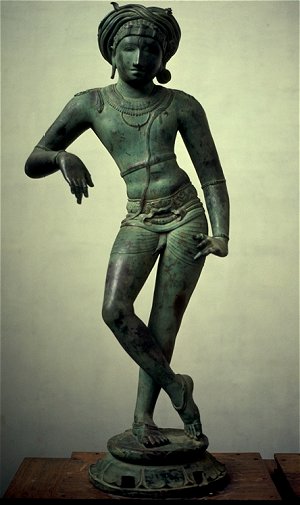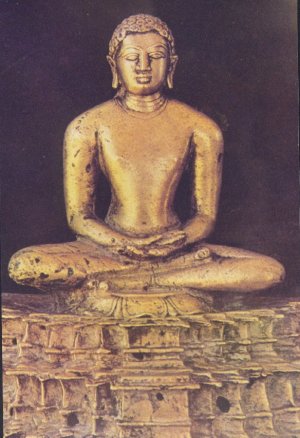Stream of Devotion
Page Last Updated: December 07, 2024
Indian culture is characterized by the continuity and eclectic nature of its religious thoughts and practices over 5,000 years of living tradition. Religion in India shared common principles of nature worship with the early religions of Egypt and Greece. The Indian way of life has been known as sanatana dharma (immortal duty) which later on was renamed as Hinduism. It was polytheistic in its seminal stages but as it went on assimilating extant influences, it took on a more monotheistic form with sectarian gods and goddesses like Shiva, Vishnu and Durga reigning supreme. The hallmark of this religion is its ability to assimilate and absorb new influences, a river that flows on perennially, gathering whatever is offered to her on the way. India is also the cradle land of Buddhism, Jainism and Sikhism. Islam, Christianity and Zoroastrianism also made their way into this land of diverse religions and percolated to the roots.Hinduism has evolved over the millennia from a sapling into a tree and from a tree into a forest. Its evolution is linked with Indian history itself. Indian society is an amalgam of many races and creeds. Hinduism has over a period of time absorbed folk and classical traditions, tangible and formless concepts of Godhead, and Dravidian and Aryan religious practices and beliefs. The religion of the Aryans was uniconic and addressed to abstract forces such as rain, wind, the sun, and dawn, but Hinduism in its popular form today revolves around mighty Gods and benevolent Goddesses.
© K. L. Kamat

Statue of Lord Shiva, Tamilnadu
The core of Hindu thought is the Upanishadic doctrine (c. 800 BC) which in essence suggests that the supreme soul (Brahman) and the individual soul (Atman) are one, and that the former manifests itself in the latter. This philosophy reappears in the Bhagavad Gita during the Epic period (between c.1000-800 BC) where the theory of selfless action is expounded. The soul is declared to be indestructible and immortal, it is recommended that man fix his sights on the absolute and perform his dharma (duty) to the best of his abilities without attachment to the outcome. Soon after the Epic period, the belief in the ideals of renunciation and love came to be emphasized and the Hindu metaphysics of reincarnation (karma) gained ground.
Hinduism teaches us that there are three ways of attaining ultimate liberation and thereby uniting with the Brahman through jnana (knowledge), karma (action) and bhakti (devotion). In the bhakti mode, the lay worshipper can have a personal communion with the God which is simpler than to contemplate upon the abstract brahman. The bhakti movement, as it is commonly called, began in southern India in the 7th century spreading to northern India in the 14th century and eventually becoming a pan-Indian phenomenon. During the period of Hindu religious revival in the 15th century, it was also influenced by the Muslim Sufi tradition.
Bhakti not only popularized the concept of adoring the personal God, but brought man closer to the Godhead through loving devotion. For example, devotion to Krishna is expressed in three ways: by vatsalya bhakti (motherly affection), sakhabhakti (friendly love) and madhura bhakti (passionate love). The bhakti movement led to the direct patronage of religious art, especially for the creation of images of deities in various forms, moods and dispositions. There exist threads of remarkable semblance between the modes of worship in the various Indian religious traditions.
- Path of Devotion -- Explore the Bhakti movement in India including the important proponents. A supplemental photo exhibition shows devout Indians at worship.
The concept of image worship in India came about only around the beginning of the Christian era, when iconographical attributes were standardized and widely accepted. The images were either in anthropomorphic form or abstract symbolic form. Some were also in theoremorphic form. Images for veneration ranged from icons in stone to terracotta and metal. Even manuscripts on palm leaf and paper with written and illustrated texts were worshipped before use.
Taking birth in eastern India, Jainism and Buddhism spread far and wide at a time when the authority of the Vedas and Vedic priests was on the wane and Vedic sacrifices and brahmanical rituals were beginning to be questioned. These two religions contributed to a temporary decline of Hinduism. Their teachers preached a simple creed of right conduct, which was in their view the right karma(retribution for the deed done) to obtain release from samsara (endless cycle of birth and death). They preached the practice of ahimsa (non-injury) to living beings as their cardinal commandment. The brahmanical Hindu philosophy of samsara and karma were deliberated upon by the Buddha as well as the Jains. But their views were different from the Hindus.
© K. L. Kamat

A Statue of Meditating Mahavira
Jain artifact from Shravanabelagola
Like the Jains, the Buddhists denied or doubted the existence of a supreme creative spirit, and instead inculcated reverence for the enlightened. Unlike the Jains, they did not believe in an immortal soul, and considered rigid penance as equally unrewarding as indulgence in sensual pleasure. The Jains endowed the animate and the inanimate with souls and gave a wider scope to the doctrine of non-violence.
Vardhamana Mahavira, a contemporary of Buddha and the last of the twenty four tirthankaras (liberators) of the Jain religion belonged to a Jnatrika clan of Kundapura, near Vaishali in northern Bihar. He forsook the world at the age of thirty and wandered as a naked ascetic practicing severe penance. He became the head of a sect called Nirgranthas ("free from fetters") known in later times as Jains or followers of Jina of ("the conqueror"). Jainism's spread from Bihar to southern and western India towards the close of the 4th century BC led to a large following amongst the common masses.
- Buddhism Potpourri
- Jainism Potpourri -- A brief introduction, artifacts and arts of Jains. Also a brief survey of Jain monuments.
Sikhism was founded by Guru Nanakdev during the period of religious revival in the early l5th century. He emphasized the fundamental truth underlying all religions and thus the chief features of this religion are its non-sectarian character and its harmony with secular life. Sikhism originally derived from Hinduism. It is a religion that is not based on image worship but bestows ultimate reverence on the sacred book, the Guru Granth Sahib. It is a conduct-based religion which restricts its followers from several worldly pleasures. There were ten gurus who succeeded Guru Nanak, the last being Guru Gobind Singh who introduced a special type of baptism called khalsa after which the appellation of Singh was suffixed to a devotee's name. To defend the faith, Guru Gobind Singh trained his followers to be brave and courageous. He commanded that they should wear breeches (kaccha) and long hair (kesa) and carry a comb (kangha), sword (kirpana) and a steel bracelet (kara).
Even since the 8th century, Islam had been percolating into Indian society from its northwestern borders. By the 14th century, there were several Muslims sultanates in eastern and southern India. Overlooking the fanatical skirmishes between Hindus and Muslims, the impact of Islam on Indian culture reflects several positive viewpoints and facts. Islamic knowledge brought medicine, astronomy, astrology, mathematics, science and music to India. Mysticism and devotional Sufi thoughts and poems led to parallelism in the cult of bhakti burgeoning in India at that time. Urdu, the language of the courts and the literati was born on Indian soil, combining Arabic, Persian, Hindi and Sanskrit. Islamic art and architecture in particular bear witness to the amalgamation of Hindu culture.
In India, whether a religion is governed by conduct or ritual, the final goal is to obtain communion with the Almighty. This goal is realized by different modes of worship. The study of religious art reveals the manner in which visual art has disseminated religious teaching, mythology and philosophy and aroused the fervor of the common man. The spiritual and ritual aspects of most native and foreign religions in India have manifested in artistic form using visual, performing and literary arts as their media of expression. It is on this note of concurrence that one may look at Indian religious art with its icons, manuscripts and ritual accessories.
![]()
See Also:
- God is Indian -- India is the most religious country in the world. A profile of India's great religions, and influence of some of the foreign faiths.
- Path of Devotion -- Explore the Bhakti movement in India including the important proponents. A supplemental photo exhibition shows devout Indians at worship.

